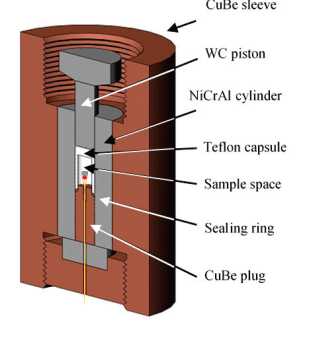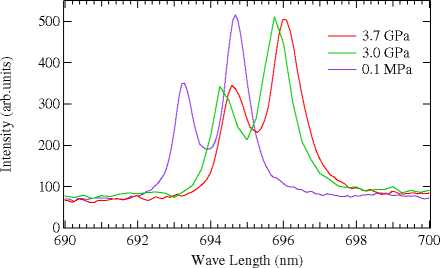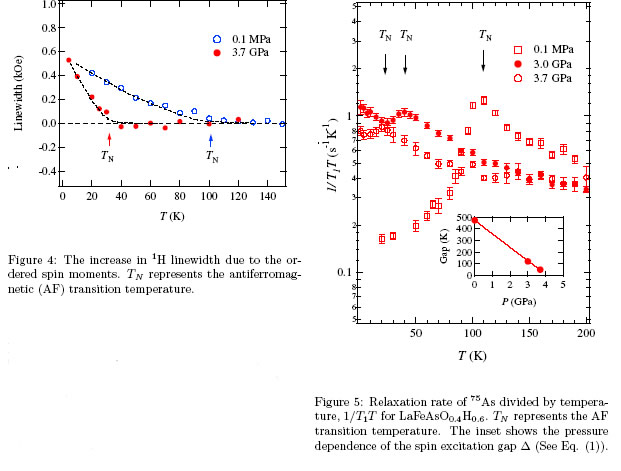Servicios Personalizados
Revista
Articulo
Indicadores
-
 Citado por SciELO
Citado por SciELO
Links relacionados
-
 Similares en
SciELO
Similares en
SciELO
Compartir
Papers in physics
versión On-line ISSN 1852-4249
Pap. Phys. vol.11 no.1 La Plata jun. 2019
http://dx.doi.org/10.4279/PIP.110002
Nuclear magnetic resonance on LaFeAsO0.4H0.6 at 3.7 GPa
N. Fujiwara,12 * M. Takeuchi,2 T. Kuwayama,2S. Nakagawa,2 S. Iimura,3 S. Matsuishi,4 H. Hosono2,3
1*E-mail: naoki@fujiwara.h.kyoto-u.ac.jp
2Graduate School of Human and Environmental Studies, Kyoto University, Yoshida-Nihonmatsu-cyo, Sakyo-ku, Kyoto 606-8501, Japan.
3Institute for Innovative Research, Tokyo Institute of Technology, 4259 Nagatsuda, Midori-ku, Yokohama 2268503, Japan.
4Materials Research Center for Element Strategy, Tokyo Institute of Technology, 4259 Nagatsuda, Midori-ku, Yokohama 226-8503, Japan.
Received: 28 October 2018, Accepted: 29 April 2019 DOI: http://dx.doi.org/10.4279/PIP.110002
Abstract
A prototypical electrondoped iron-based superconductor LaFeAsOi-xHx undergoes an antiferromagnetic (AF) phase for x > 0.49. We have performed nuclear magnetic resonance (NMR) measurements on LaFeAsO0.4H0.6 at 3.7 GPa to investigate the magnetic properties in the vicinity of a pressure-induced quantum critical point (QCP). The linewidth of 2H-NMR spectra broadens at low temperatures below 30 K, suggesting that the spin moments remain ordered at 3.7 GPa. The coexistence of gapped and gapless spin excitations was confirmed in the ordered state from the relaxation time T1 of 75 As. The pressure-induced QCP is estimated to be 4.1 GPa from the pressure dependence of the gapped excitation.
Keywords: NMR, high pressure, iron pnictide, superconductor
A prototypical electron-doped iron-based pnictide LaFeAsOi_xHx (0 < x < 0.6) exhibits unique elec-tronic properties in a heavily carrier-doped regime: a superconducting (SC) phase with double-domes structure expands in a wide regime (0.05 < x < 0.49) 1 and an antiferromagnetic (AF) phase manifests itself by further H doping (0.49 < x) 2-4. Band calculations show that both Fermi surfaces and nesting vectors change by H doping: the two hole pockets present at r point in the lightly H-doped regime almost disappear in the heavily H-doped regime 5,6. The change in the nesting vectors due to H doping would cause a change in wave-vector (q) dependent spin susceptibility x(q, w) and would allow for the appearance of two AF phases in the lightly and heavily H-doped regimes.
The AF phase in the heavily H-doped regime is strongly suppressed upon applying pressure 7. We have performed nuclear magnetic resonance (NMR) measurements on LaFeAsO0.4H0.6 at 3.7 GPa, and we have found that the spin excitation gap appearing at the AF phase vanishes at around 4.1 GPa. We have investigated the magnetic properties in the vicinity of a pressure-induced quantum critical point (QCP)(~4.1 GPa).
II. Experimental apparatuses and conditions
A pressure of 3.7 GPa was applied using a NiCrAl-hybrid clamp-type pressure cell as shown in Fig. 1 8. We have used a mixture of Fluorinert FC-70 and FC-77 as the pressure-transmitting medium. A coil wounded around the powder samples and an optical fiber with the Ruby powders glued on top were inserted into the sample space of the pressure cell 8. The size of the coil was 2.4 mm in di-ameter and 3.5 mm in length, and the number of windings was 18 turns. The pressure was monitored through Ruby fluorescence measurements. The R1 and R2 lines at ambient pressure, 3.0 and 3.7 GPa are shown in Fig. 2. The wavelength of the R1 or R2 peak shifts linearly with respect to pressure. The shift of the wavelength AA satisfies the relation P (GPa)=AA(nm)/0.365.

Figure 1: A NiCrAl-hybrid clamptype pressure cell 8. A coil wounded around the powder samples and an op-tical fiber with the Ruby powders were inserted into the sample space.

Figure 2: Ruby fluorescence spectra. The smaller and larger peaks correspond to the R2 and R1 transitions, respectively.
NMR measurements for the powder samples were acquired using a conventional coherent-pulsed NMR spectrometer. The relaxation rate (1/T1) was measured using a conventional saturation-recovery method for the samples whose FeAs planes are parallel to the applied field.
i. 1H-NMR spectra
75 As(I = 3/2)-NMR spectra broaden due to the nuclear quadrupole interaction, which makes difficult to investigate the antiferromagnetic (AF) state. However, 1H(I = 1/2) is free from the nuclear quadrupole interaction. Therefore, the 1H signal is narrow at a paramagnetic state, and the broad-ening in the AF phase directly reflects the magnitude of the spin moments. Figure 3 shows 1H-NMR spectra measured at 3.7 GPa and 35.1 MHz. The sharp signal of 9F originates from the pressure-transmitting medium mentioned above. The temperature dependence of the linewidth is shown in Fig. 4 together with the data at ambient pressure 2,4. The onset of the broadening in Fig. 4 cor-responds to the AF transition temperature (TN). The maximum spin moment is estimated to be 1.80 4. As seen in Fig. 4, TN is about 100 K at ambient pressure and decreases to 30 K at 3.7 GPa. The pressure-induced QCP is expected at a much higher pressure regime.
The relaxation rate divided by temperature 1/T1T provides a measure of low-energy spin fluctuations. In general, neglecting the wave-number (q) dependence of the hyperfine coupling constant, 1/T1T is proportional to the imaginary part of the susceptibility: 1/T1T « Imx(?,w)/w where w represents
a NMR frequency. 75 As is preferred to 1H for T1 measurements, because FeAs layers are hardly af-fected by the random distrubution of hydrogen in LaO1-xHx layers. Furthermore, owing to the nuclear quadrupole interaction, one can pick up the 75 As signals coming from the powders whose FeAs planes are parallel to the applied field.
1/T1T for 75 As, and the peaks correspond to Tn . The values of TN determined from 1/T1T are consistent with those obtained from the linewidth of 1H. At low temperatures just below TN, 1/T1T is expressed as follows:
![]()
where A represent the spin excitation gap. The pressure dependence of A is shown in the inset to Fig. 5. Assuming that A shows the linear depen-dence, the pressure-induced QCP is estimated to be 4.1 GPa.
The activated spin excitation as shown in Eq. (1) originates from a spin density wave (SDW). How-ever, 1/T1T also shows Curie-Weiss behavior below
Tn . The behavior is not observed at ambient pres-sure and it is characteristic of the critical behavior near the pressure-induced QCP. The coexistence of the gapped and gapless excitations are specific to this system. In this system, major Fermi surfaces are electron pockets with a square-like shape in two dimensional k space. Some parts of the electron pockets would contribute to the nesting and the SDW formation. The critical behavior would originate from the other parts of the Fermi sur-faces. The nesting condition becomes worse and the bandwidth becomes broader with increasing pres-sure. Owing to these effects, the activated behavior shown in Eq. (1) would disappear at the pressure-induced QCP.
We performed NMR measurements on LaFeAsOcuHo.6 at 3.7 GPa to investigate the magnetic properties in the vicinity of the pressure-induced QCP. We have found that the SDW ordered state still remains at 3.7 GPa. The pressure-induced QCP is estimated to be 4.1 GPa from the pressure dependence of the spin excitation gap. The gapless excitation observed as the Curie-Weiss behavior of \/T\T coexists with the gapped excitation, implying that each excitation originates from different parts within the Fermi surfaces.
Acknowledgements - This work is supported by JSPS KAKENHI Grant Number JP18H01181, and a grant from Mitsubishi Foundation. We thank H. Kontani and H. Takahashi for discussion.
1 S Iimura, S Matsuishi, H Sato, T Hanna, Y Muraba, S W Kim, J E Kim, M Takata, H Hosono, Two-dome structure in electron-doped iron arsenide superconductors, Nat. Commun. 63, 943 (2012). [ Links ]
2 N Fujiwara, S Tsutsumi, S Iimura, S Matsuishi, H Hosono, Y Yamakawa, H Kon-tani, Detection of antiferromagnetic order-ing in heavily doped LaFeAsOi-xHx pnic-tide superconductors using nuclear-magnetic-resonance techniques, Phys. Rev. Lett. 111, 097002 (2013). [ Links ]
3 M Hiraishi, S Iimura, K M Kojima, J Yamaura, H Hiraka, K Ikeda, P Miao, Y Ishikawa, S Torii, M Miyazaki, I Yamauchi, A Koda, K Ishii, M Yoshida, J Mizuki, R Kadono, R Kumai, T Kamiyama, T Otomo, Y Murakami, S Matsuishi, H Hosono, Introduction to solid state physics, Nat. Phys. 10, 300 (2014). [ Links ]
4 R Sakurai, N Fujiwara, N Kawaguchi, Y Yamakawa, H Kontani, S Iimura, S Matsuishi, H Hosono, Quantum critical behavior in heavily doped LaFeAsOi-xHx pnictide superconductors analyzed using nuclear magnetic resonance, Phys. Rev. B 91, 064509 (2015). [ Links ]
5 Y Yamakawa, S Onari, H Kontani, N Fujiwara, S Iimura, H Hosono, Phase diagram and superconducting states in LaFeAsOi-xHx based on the multiorbital extended Hubbard model, Phys. Rev. B 88, 041106(R) (2013). [ Links ]
6 S Iimura, S Matsuishi, M Miyakawa, T Taniguchi, K Suzuki, H Usui, K Kuroki, R Ka-jimoto, M Nakamura, Y Inamura, K Ikeuchi, S Ji, H Hosono, Switching of mt'ra-o'rbital spin excitations in electrondoped iron pnictide su-perconductors, Phys. Rev. B 88, 060501(R) (2013). [ Links ]
7 N Fujiwara, N Kawaguchi, S Iimura, S Matsuishi, H Hosono, Quantum phase transition un-der pressure in a heavily hydrogen-doped iron-based superconductor LaFeAsO, Phys. Rev. B 96, 140507(R) (2017). [ Links ]
8 N Fujiwara, T Matsumoto, K K Nakazawa, A Hisada, Y Uwatoko, Fabrication and efficiency evaluation of a hybrid NiCrAl pressure cell up to 4 GPa, Rev. Sci. Instrum. 78, 073905 (2007). [ Links ]
















